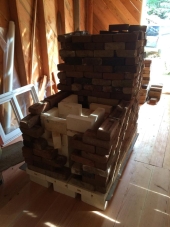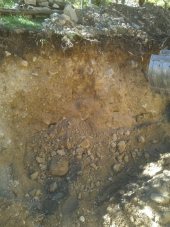So is it correct to say that if you remove the top soil and under it very hard gray or red dirt ( not sand or gravel ) then it more than likely clay?
I don't know any foolproof way just by sight or description alone that will prove a soil has clay in it. It could also be silt which is very fine sand. Use the characteristics of clay to prove itself to you by performing the tests I mentioned earlier. Another test I just remembered is to grab a handful of fairly wet soil and squeeze. Does it extrude between your fingers in fairly nice ribbons (presence of clay) or just kind of crumble and fall apart? (little or no clay)
I may also have trouble finding straw as there are not many farms here. Hay yes I can find this everywhere, but I don't know if it would be a suitable alternative.
Hay is not used in cob or as a building material as it is very likely to mold and deteriorate quickly. If you can't find a source for straw, while you are out on your clay finding walk, you could test various grasses and fibrous plants along the way (dead from last year - again, no green or fresh plants as they will deteriorate as well) by grabbing a small handful and pulling and twisting. If they break easily move onto the next candidate. I have collected dead plant matter either in the fall or early spring. Summer is usually not a good time as last years dead plants have usually decomposed too much to be strong enough for tensile strength. Last year I found some reeds that worked really well for me.
I believe I can use most anything for the mass storage bench as long as it doesn't have insulative property, ( packed dirt or fine pebbles ) but can I use refractory cement to hold the fire bricks in place? If I can't source clay?
Refractory cement is but one way to go, just make sure its rated for very high temperatures say (2000 F +) . You could also buy a bag of fire clay which will work as well. With clay, its much easier to take your stove apart to try other brick configurations without having to chip off the cement and possibly damage your bricks.
I do have "the rocket mass heater builder's guide" book that I am slowly making my way threw.
My first book was Rocket Mass Heaters -Superefficient Woodstoves YOU Can Build by Ianto Evans, Cob Cottage Company. I would recommend this book as well. More aimed towards building with what you have or can get for free or cheaply.






